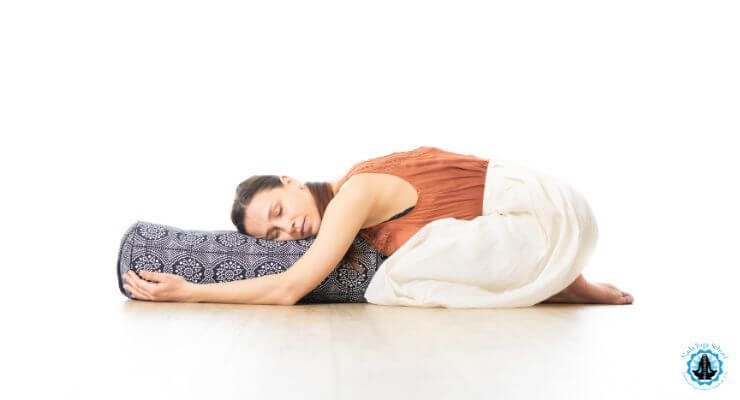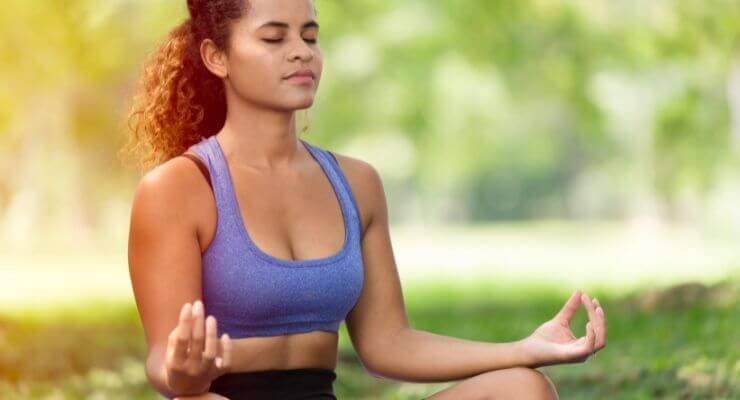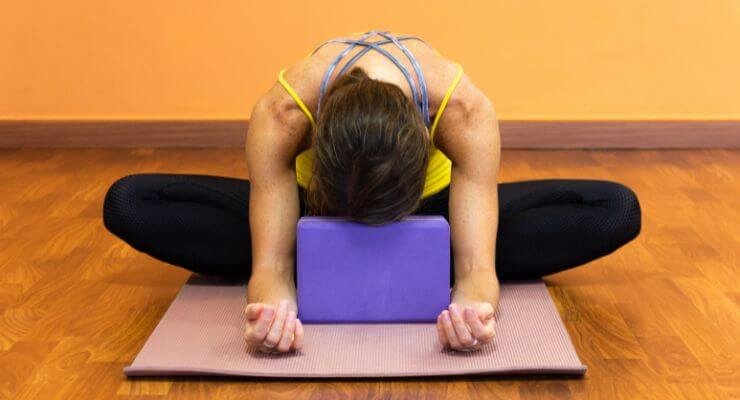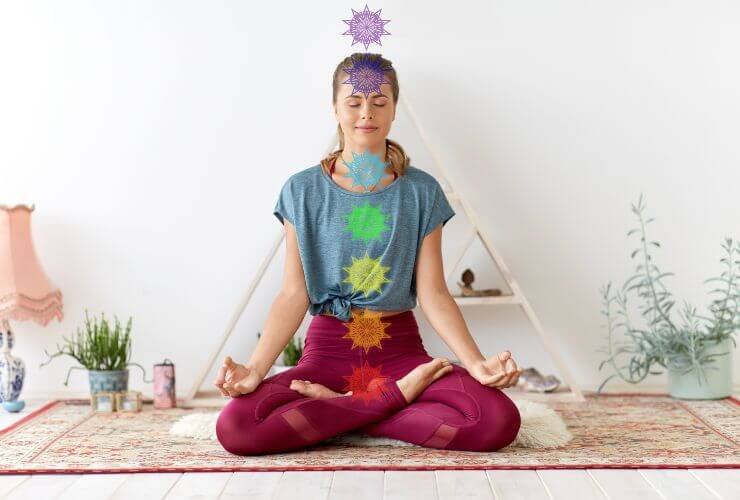Restorative yoga is a type of yoga that is designed to help individuals relax and restore their bodies and minds. It is a gentle practice that involves holding poses for a longer duration using props like blankets, blocks, and bolsters. Restorative yoga is a great way to release tension and stress in the body and improve overall well-being.
One of the main benefits of restorative yoga is that it promotes deep relaxation and stress relief. By holding poses for an extended period, the body is able to fully relax and release tension. This can help reduce stress and anxiety, improve sleep, and increase overall feelings of calm and well-being.
Restorative yoga is a great practice for individuals of all levels, including beginners. It is a gentle and accessible practice that can be modified to meet the needs of each individual. Whether you are looking to reduce stress, improve flexibility, or simply relax and unwind, restorative yoga may be just what you need.
Overall, restorative yoga is a gentle and relaxing practice that can be beneficial for anyone looking to reduce stress, improve relaxation, and promote a sense of calm and well-being.
Characteristics of Restorative Yoga
Restorative yoga is a gentle and therapeutic style of yoga that focuses on relaxation, stress relief, and healing. This section will explore the key characteristics of restorative yoga, including the emphasis on relaxation and comfort, the use of props for support and alignment, and the extended holds in gentle postures.
The Emphasis on Relaxation and Comfort
One of the defining features of restorative yoga is the emphasis on relaxation and comfort. In restorative yoga, the body is supported by props such as blankets, bolsters, and blocks, which allow the muscles to fully relax and release tension. This support also helps to reduce stress on the joints and spine, allowing the body to fully let go and surrender into each pose.
Restorative yoga classes typically feature dim lighting, calming music, and a quiet atmosphere to create a peaceful and relaxing environment. The focus is on slowing down, breathing deeply, and letting go of tension, stress, and anxiety.
Use of Props for Support and Alignment
Restorative yoga uses a variety of props to support the body in each pose and ensure proper alignment. Props such as blankets, bolsters, blocks, straps, and eye pillows are used to help the body fully relax and release tension, while also providing support and stability.
Props can be used to modify poses to make them more accessible, or to deepen the stretch and increase the benefits of each posture. The use of props also helps to prevent injury and ensure that each pose is performed safely and with proper alignment.
Extended Holds in Gentle Postures
Restorative yoga poses are typically held for longer periods of time than in other styles of yoga. This allows the body to fully relax and release tension, while also promoting deep stretching and increased flexibility. The extended holds also allow time for the mind to quiet down and for the breath to deepen, promoting a sense of calm and relaxation.
Restorative yoga poses are gentle and accessible to all levels, making it a great practice for beginners, those recovering from injury or illness, or anyone looking to reduce stress and promote relaxation.
Overall, restorative yoga is a gentle and therapeutic practice that emphasizes relaxation, comfort, and healing. The use of props, extended holds, and gentle postures make it accessible to all levels, while also providing numerous physical, mental, and emotional benefits.
Benefits of Restorative Yoga
Restorative yoga is a gentle form of yoga that focuses on relaxation and stress relief. It offers a wide range of benefits to both the mind and body. Here are some of the benefits of restorative yoga:
1. Reduces Stress and Anxiety
Restorative yoga promotes deep relaxation, which can help reduce stress and anxiety levels. It activates the parasympathetic nervous system, which is responsible for calming the body and mind.
2. Improves Sleep Quality
Restorative yoga can improve the quality of sleep by reducing stress and promoting relaxation. It also helps to calm the mind and body, making it easier to fall asleep and stay asleep.
3. Increases Flexibility and Range of Motion
Restorative yoga includes gentle stretches that help to increase flexibility and range of motion. It can also help to reduce muscle tension and stiffness.
4. Boosts Immune System
Restorative yoga can help to boost the immune system by reducing stress and promoting relaxation. It also stimulates the lymphatic system, which helps to remove toxins from the body.
5. Lowers Blood Pressure
Restorative yoga can help to lower blood pressure by reducing stress and promoting relaxation. It also helps to improve circulation, which can help to reduce the risk of heart disease.
Overall, restorative yoga is a great way to reduce stress, improve sleep quality, increase flexibility, boost the immune system, and lower blood pressure. It is suitable for people of all ages and fitness levels and can be practiced at any time of the day.
The Science Behind Restorative Yoga
Restorative yoga is a form of yoga that emphasizes relaxation and deep rest. The practice is known to have several therapeutic benefits, including reducing stress and anxiety, improving sleep, and promoting overall well-being.
How relaxation affects the nervous system
Restorative yoga involves holding poses for extended periods of time, often with the help of props such as blankets, bolsters, and blocks. The prolonged holding of poses can activate the parasympathetic nervous system, which is responsible for the body’s relaxation response. This response helps to counteract the effects of the sympathetic nervous system, which is responsible for the body’s stress response.
Reducing stress hormones through Restorative Yoga
Research has shown that restorative yoga can reduce levels of the stress hormone cortisol in the body. Cortisol is produced by the adrenal glands in response to stress, and high levels of cortisol over an extended period of time can have negative effects on health, including increased risk of heart disease, diabetes, and depression.
Research on the therapeutic benefits of the practice
Several studies have investigated the therapeutic benefits of restorative yoga. A 2014 study found that restorative yoga can improve sleep quality and reduce symptoms of anxiety and depression in breast cancer survivors. Another study found that restorative yoga can improve symptoms of chronic fatigue syndrome.
In conclusion, restorative yoga is a form of yoga that emphasizes relaxation and deep rest. The practice has several therapeutic benefits, including reducing stress and anxiety, improving sleep, and promoting overall well-being. The science behind restorative yoga suggests that the practice can activate the parasympathetic nervous system, reduce levels of the stress hormone cortisol, and improve symptoms of anxiety, depression, and chronic fatigue syndrome.
Restorative Poses and Sequences
Key Restorative Yoga poses (Savasana, Supta Baddha Konasana, Child Pose, etc.)
Restorative yoga is all about finding relaxation and calmness in the body and mind. Key restorative yoga poses include Savasana, Supta Baddha Konasana, Child Pose, and more. These poses are designed to release tension from the body and promote deep relaxation.
Savasana, also known as Corpse Pose, is a classic restorative pose that involves lying flat on the back with the arms and legs relaxed. Supta Baddha Konasana, also known as Reclined Bound Angle Pose, is another restorative pose that involves lying on the back with the knees bent and the soles of the feet together. Child Pose is a gentle forward bend that stretches the spine and promotes relaxation.
Creating a restorative sequence for home practice
Creating a Restorative Yoga sequence for home practice involves selecting poses that promote relaxation, stress relief, and gentle stretching. Remember to use props like yoga blocks, bolsters, blankets, and cushions to support your body in these poses.
Here’s a simple Restorative Yoga sequence you can follow:
1. Child’s Pose (Balasana)
- Start in a kneeling position with your big toes touching and knees apart.
- Sit back on your heels and stretch your arms forward, lowering your chest toward the floor.
- Place a bolster or folded blankets under your chest and head for support.
- Relax in this pose for 5-7 breaths, focusing on deep, calming breaths.
2. Supported Bridge Pose (Setu Bandha Sarvangasana)
- Lie on your back with your knees bent and feet hip-width apart.
- Slide a yoga block under your sacrum (the flat bone at the base of your spine).
- Allow your arms to rest by your sides with palms facing up.
- Stay in this pose for 5-7 minutes, allowing your spine to gently arch and open.
3. Legs Up the Wall Pose (Viparita Karani)
- Sit with your side against a wall, your knees bent, and your feet flat on the floor.
- As you recline, swing your legs up the wall and lie down.
- Place a bolster or cushion under your hips for added support.
- Relax your arms by your sides or on your abdomen.
- Hold this pose for 10-15 minutes to promote relaxation and improve circulation.
4. Supported Reclining Bound Angle Pose (Supta Baddha Konasana)
- Lie on your back with your knees bent and feet together.
- Allow your knees to drop open to the sides.
- Place yoga blocks or bolsters under your thighs for support.
- Rest your arms by your sides with palms facing up.
- Close your eyes and hold for 5-7 minutes, focusing on your breath.
5. Savasana (Corpse Pose)
- Extend your legs and arms comfortably apart, palms facing up.
- Use a rolled blanket or cushion under your knees for lower back support if needed.
- Close your eyes and focus on deep, mindful breathing.
- Stay in Savasana for at least 10-15 minutes, allowing complete relaxation.
6. Seated Meditation
- After Savasana, sit in a comfortable seated position.
- Place your hands on your lap or in a mudra (hand gesture) of your choice.
- Meditate for 5-10 minutes, focusing on your breath or a specific intention.
Remember to maintain slow and steady breathing throughout the sequence. The aim of this Restorative Yoga practice is deep relaxation, so take your time and let go of any tension in your body and mind. Feel free to modify the poses or use additional props as needed to enhance your comfort and relaxation. Enjoy your peaceful home practice!
The importance of proper alignment and adjustments
Proper alignment and adjustments are important in restorative yoga to ensure that each pose is performed safely and effectively. It is important to use props such as blankets, bolsters, and blocks to support the body in each pose and to make adjustments as needed to ensure proper alignment.
In restorative yoga, adjustments should be gentle and supportive. The goal is to promote relaxation and release tension, not to push the body beyond its limits. It is important to listen to the body and make adjustments as needed to ensure that each pose is comfortable and effective.
How to Practice Restorative Yoga at Home
Restorative yoga is a gentle form of yoga that focuses on relaxation and stress relief. It involves holding poses for extended periods, with the support of props such as blankets, bolsters, and blocks. Practicing restorative yoga at home can be a great way to unwind and de-stress after a long day. Here are some tips for creating a restorative yoga practice in your own home.
Creating a Calm Environment
Creating a calm environment is essential for a restorative yoga practice. Find a quiet, peaceful space in your home where you can practice without distractions. Dim the lights or light some candles to create a soothing atmosphere. You may also want to play some soft music to help you relax.
Choosing the Right Props
Using props is an important part of restorative yoga, as they help support the body in each pose. Some common props include blankets, bolsters, blocks, and straps. Make sure you have all the props you need before you start your practice. You can also get creative with household items, such as using a stack of books as a makeshift block.
Setting Intentions for Your Practice
Before you begin your practice, take a moment to set an intention. This can be as simple as focusing on your breath, or as specific as setting a goal for your practice. Setting an intention can help you stay focused and present throughout your practice.
During your practice, focus on your breath and allow yourself to fully relax into each pose. Remember that restorative yoga is about letting go of tension and stress, not pushing yourself to your limits. Take your time and enjoy the peaceful, calming benefits of this gentle practice.
Restorative Yoga for Special Considerations
Restorative yoga is a gentle form of yoga that is ideal for people who need to reduce stress, relax, and restore their energy levels. It is also a great option for people who have special considerations, such as chronic pain, illness, or pregnancy. Here are a few ways that restorative yoga can be used for special considerations.
Using Restorative Yoga for stress management
Restorative yoga is an excellent tool for managing stress. It can help to reduce the levels of cortisol in the body, which is a hormone that is released during times of stress. By reducing cortisol levels, restorative yoga can help to promote relaxation and reduce anxiety.
One of the key benefits of restorative yoga is that it involves holding poses for an extended period of time. This allows the body to relax deeply, helping to reduce tension in the muscles and promote a sense of calm. Additionally, restorative yoga often incorporates breathing exercises, which can help to further promote relaxation and reduce stress.
Coping with chronic pain and illness
Restorative yoga can also be beneficial for people who are coping with chronic pain or illness. It can help to reduce pain levels and improve overall quality of life. Restorative yoga poses are gentle and non-invasive, making them ideal for people who may be experiencing pain or discomfort.
One of the key benefits of restorative yoga for people with chronic pain or illness is that it can help to improve circulation and reduce inflammation. This can help to reduce pain levels and promote healing. Additionally, restorative yoga can help to improve flexibility and range of motion, which can be beneficial for people who are experiencing stiffness or limited mobility.
Prenatal and postnatal Restorative Yoga
Restorative yoga is also an excellent option for pregnant women and new mothers. It can help to reduce stress, improve sleep, and alleviate common pregnancy-related discomforts, such as back pain and swelling.
During pregnancy, restorative yoga can be modified to accommodate the changing needs of the body. For example, props such as bolsters, blankets, and blocks can be used to support the body and provide additional comfort. After giving birth, restorative yoga can also be beneficial for helping the body to recover and regain strength.
In conclusion, restorative yoga is a versatile and effective practice that can be used to address a variety of special considerations. Whether you are looking to manage stress, cope with chronic pain or illness, or support a healthy pregnancy, restorative yoga can be a valuable tool for promoting relaxation, healing, and overall well-being.
Restorative Yoga vs Other Yoga Styles
Restorative yoga is a gentle, slow-paced style of yoga that focuses on relaxation and stress relief. It is different from other yoga styles in several ways.
Pace and Intensity
Restorative yoga is much slower and gentler than other yoga styles, such as vinyasa or power yoga. In restorative yoga, the poses are held for longer periods of time, typically 5-10 minutes or more. This allows the body to fully relax and release tension.
Other yoga styles, on the other hand, are more fast-paced and intense. They often involve flowing from one pose to the next, and may include more challenging poses that require strength and flexibility.
Active vs Passive
In restorative yoga, the focus is on passive stretching. The poses are designed to be comfortable and relaxing, and are often supported by props such as blankets, bolsters, and blocks. This allows the body to release tension and stress without exerting any effort.
Other yoga styles are more active, and may involve more dynamic movements and poses that require active engagement of the muscles.
Breathwork
Restorative yoga often includes specific breathing techniques, such as deep belly breathing or alternate nostril breathing. These techniques can help to calm the nervous system and reduce stress and anxiety.
Other yoga styles may also include breathwork, but it is often incorporated into the movement of the poses rather than practiced separately.
Benefits
Restorative yoga has many benefits, including stress relief, improved flexibility, and better sleep. It can also be helpful for those with chronic pain or injuries, as the gentle stretching can help to relieve tension and promote healing.
Other yoga styles also have many benefits, such as improved strength, flexibility, and balance. They can also be a great way to reduce stress and improve overall health and well-being.
Overall, restorative yoga is a unique and valuable addition to any yoga practice. Its gentle, relaxing nature can help to reduce stress and promote deep relaxation and healing.
Precautions and Contraindications
While restorative yoga is generally considered safe for most people, there are some precautions and contraindications to keep in mind. It is always advisable to consult with a healthcare professional before beginning any new exercise program, especially if you have any medical conditions or injuries.
Here are some precautions and contraindications to consider before practicing restorative yoga:
- Pregnancy: Restorative yoga can be a great practice for pregnant women, but it is important to modify certain poses and avoid others. It is best to consult with a prenatal yoga teacher or healthcare professional before practicing restorative yoga while pregnant.
- Injuries: If you have any injuries, especially to your back, neck, or shoulders, it is important to be cautious when practicing restorative yoga. Some poses may need to be modified or avoided altogether.
- Chronic pain: While restorative yoga can be helpful for managing chronic pain, it is important to listen to your body and avoid any poses that cause discomfort or exacerbate your pain.
- High blood pressure: Some restorative yoga poses, such as inversions, can increase blood pressure. If you have high blood pressure, it is important to avoid these poses or modify them as needed.
- Glaucoma: Inversions can also increase intraocular pressure, which can be dangerous for people with glaucoma. If you have glaucoma, it is important to avoid inversions or modify them as needed.
- Recent surgery: If you have had recent surgery, it is important to consult with your healthcare provider before practicing restorative yoga. Some poses may need to be avoided or modified until you have fully recovered.
Overall, restorative yoga can be a safe and beneficial practice for most people, but it is important to be aware of any precautions or contraindications that may apply to you. By practicing mindfully and listening to your body, you can enjoy the many benefits of restorative yoga while avoiding any potential risks.
Frequently Asked Questions
What are some benefits of practicing restorative yoga?
Restorative yoga has numerous benefits, such as reducing stress and anxiety, improving sleep quality, increasing flexibility and range of motion, and promoting deep relaxation. It can also help to lower blood pressure, improve digestion, and boost the immune system.
How does restorative yoga differ from other types of yoga?
Restorative yoga is a slower and more passive form of yoga that emphasizes relaxation and restoration of the body and mind. Unlike other types of yoga that may focus on building strength or flexibility, restorative yoga uses props such as bolsters, blankets, and blocks to support the body in gentle poses held for longer periods of time.
What are some common props used in restorative yoga?
Some common props used in restorative yoga include bolsters, blankets, blocks, straps, and eye pillows. These props are used to support the body in various poses, allowing for deeper relaxation and release of tension.
What are some key principles of restorative yoga?
The key principles of restorative yoga include using props to support the body, focusing on the breath, holding poses for longer periods of time, and practicing in a quiet and calming environment. The practice is intended to promote deep relaxation and restoration of the body and mind.
Can restorative yoga be practiced by beginners?
Yes, restorative yoga is appropriate for all levels, including beginners. It is a gentle and slow-paced practice that can be modified to accommodate individual needs and abilities.
What are some tips for creating a restorative yoga sequence?
When creating a restorative yoga sequence, it is important to focus on poses that promote relaxation and release of tension. Some key poses to include are supported child’s pose, legs-up-the-wall pose, and reclining bound angle pose. It is also important to use props to support the body in each pose and to allow for enough time in each pose to fully relax and release tension.





